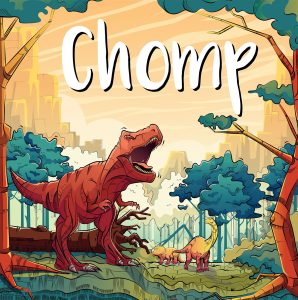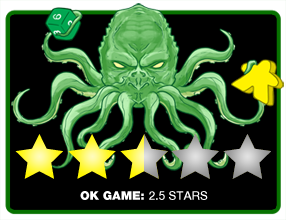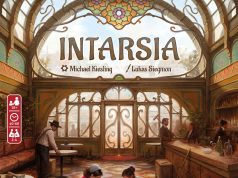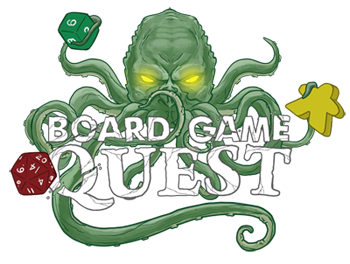 I used to think there weren’t enough dinosaur-themed board games in the world, but now … well, I still think that, but I’m less adamant about it. Dinosaurs are super cool and all, but the difficulty in abstracting them into a board-game setting is that you lose a lot of what makes them interesting. Without the spectacle, archeological fantasy, and imminent threat to human life, dinosaurs in board games aren’t much different than normal animals, which demotes the theme to mere set-dressing.
I used to think there weren’t enough dinosaur-themed board games in the world, but now … well, I still think that, but I’m less adamant about it. Dinosaurs are super cool and all, but the difficulty in abstracting them into a board-game setting is that you lose a lot of what makes them interesting. Without the spectacle, archeological fantasy, and imminent threat to human life, dinosaurs in board games aren’t much different than normal animals, which demotes the theme to mere set-dressing.
Chomp is certainly not setting out to buck this trend. The only two dinosaur facts you need to know for this game are that (a) some dinosaurs eat other dinosaurs, and (b) dinosaurs lay eggs, and you’re all set. The theme is just a bit of paint–but is it decorating a good game?
Chomp is a card/tile-laying game for 1-4 players, which takes about 20 minutes to play.
Gameplay Overview:
Chomp takes place over nine turns, and on each turn, you will take a single large, square card from a display of six and place it in your play area. The cards are double-sided, with an endgame scoring condition on one side, and a 2×2 grid of land spaces on the other; the display always has three cards available goal-side up and three available land-side up, and you cannot flip over cards once you have taken them.

Goal cards are simply placed in your play area when you take them, whereas land cards must be placed in your land. Land cards can be rotated and overlapped to your heart’s desire, but your land must be a single contiguous area. Additionally, while most dinosaurs only take up a 1×1 space on their card, the large dinosaurs take up a 2×1 space, and you cannot half-cover one of these double spaces. Some cards also have an egg icon on them, and when played, these allow you to place an egg token on an empty nest in your land, which scores you points at the end of the game.
After nine turns, the deck will be empty, and players continue to score—but first, you have to kill some dinosaurs. Dinosaurs next to tar spaces immediately die, carnivores eat herbivores if they can, and herbivores eat plants if they can, with any unfed dinosaurs also being killed. Once the extinction process has completed, you score points for any eggs and surviving dinosaurs in your land, as well as the goal cards you acquired during the game. The player with the most points wins.

Game Experience:
I believe a good tile-laying game needs a compelling hook to stand out, and Chomp … doesn’t really have one. It’s a functionally designed game with reasonably interesting decisions, but none of its design choices come together in any meaningful way.

The core drafting mechanism in Chomp is good enough—each turn, you’re choosing between whether to give yourself more scoring opportunities or to expand your land in order to exploit those opportunities. Unfortunately, this choice doesn’t have as much tension as in other games, because adding to your land doesn’t feel particularly rewarding. Every tile placement will likely kill almost as many dinosaurs as it adds, so you rarely feel like you’re making smart or interesting plays.
That tactical malaise is compounded by the extinction process priot to the scoring phase, which is arguably Chomps’ biggest innovation, and also its worst element by a wide margin. Depending on player count, figuring out which dinosaurs live and which go extinct can take as long as the actual game does. It also makes your choices during the game less impactful, because it’s difficult to know how a placement will affect which dinosaurs survive without meticulously analyzing your board state… which drags out a game already prone to analysis paralysis.

I would be willing to forgive these contradictions in the name of a crunchy, small-box filler, if it weren’t for the infuriating production choices on display. Chomp comes in a small box, but the cards are two to three times larger than they need to be; as a result, the game has a shockingly large table footprint, even with just two players. You would think the benefit of such large cards is the ability to show off some artistic prowess, but the card art is equal parts drab and difficult to parse. All carnivores are red and all herbivores are yellow, with only size and minor visual differences to tell them apart. It’s an incredibly lazy choice, and it makes the game state even harder to understand at a quick glance.
Final Thoughts:
I really wanted to like Chomp, but it unfortunately doesn’t hang together in an appreciable way. Nothing about it is broken or terrible, but neither is anything particularly interesting or innovative—and there are enough minor frustrations to push me towards other designs. There is a wealth of small, crunchy tile-laying games (even from this same company!), and Chomp doesn’t do enough to avoid extinction in that ecosystem.
Final Score: 2.5 Stars – A totally acceptable filler, with too many design and production issues to really recommend to anyone.
 Hits:
Hits:
• Quick to set up and play
• Card-based tile-laying is always fun
• Cute artwork
Misses:
• Not particularly interesting or innovative
• Turns can drag on
• Annoying end-game scoring procedure
• Frustrating production choices






















“A totally acceptable filler, with too many design and production issues to really recommend to anyone” is how I’ve felt about just about every Allplay title I’ve played so far. The only one I think I’ll feel differently about when I get it to the table is Sail. I also loved Ruins’ predecessor, Custom Heroes, so I look forward to grabbing it.
There are a series of games that seem to get glowing reviews from the Big Five (or whatever) review accounts on YouTube. Chomp, Vivid Memories, etc. And each time I fail to learn the lesson and wait and see. This one we preordered and played with my sons once (who were thrilled to see it come in). And almost immediately we knew the reality. A real bummer. But lesson learned (finally!…until the next hot game)